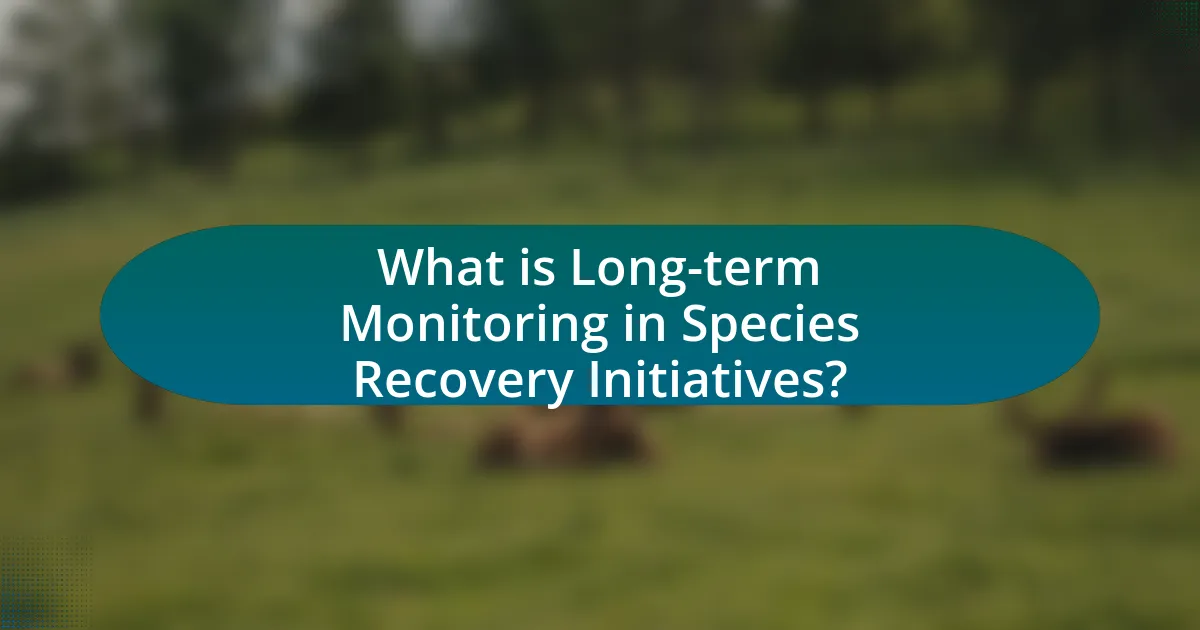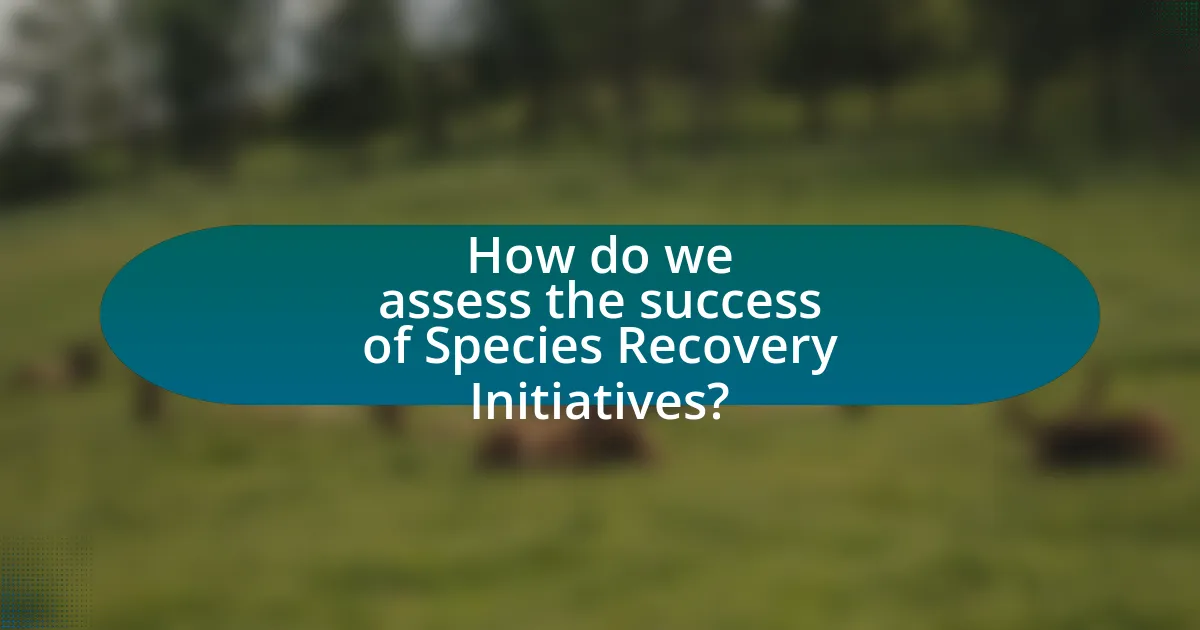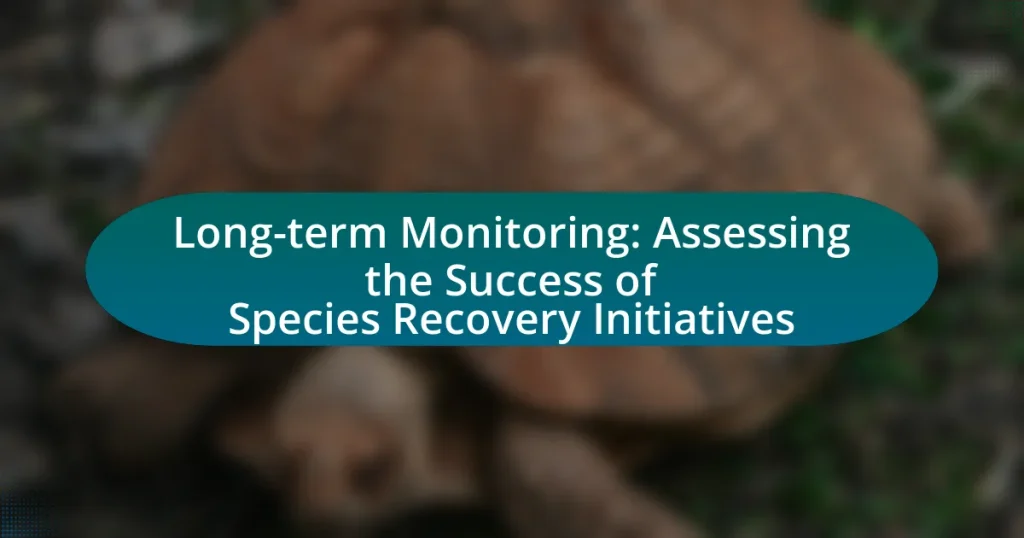Long-term monitoring is a critical component of species recovery initiatives, involving systematic observation and assessment of species populations and their habitats over extended periods. This process provides essential data on population trends, reproductive success, and habitat conditions, enabling conservationists to evaluate the effectiveness of recovery strategies and adapt management practices accordingly. Key objectives include tracking changes in population dynamics and ecosystem health, while challenges such as funding limitations and data consistency must be addressed. The article outlines best practices for effective monitoring, the role of technology and citizen science, and the metrics used to assess recovery success, ultimately highlighting the importance of collaborative efforts among stakeholders in enhancing conservation outcomes.

What is Long-term Monitoring in Species Recovery Initiatives?
Long-term monitoring in species recovery initiatives refers to the systematic observation and assessment of species populations and their habitats over extended periods. This process is essential for evaluating the effectiveness of conservation strategies, as it provides data on population trends, reproductive success, and habitat conditions. For instance, studies have shown that long-term monitoring can reveal critical insights into the recovery trajectories of endangered species, such as the California condor, where consistent data collection has informed management decisions and improved survival rates.
How does Long-term Monitoring contribute to species recovery?
Long-term monitoring contributes to species recovery by providing essential data on population trends, habitat conditions, and threats over time. This continuous assessment allows conservationists to identify successful recovery strategies and adapt management practices based on real-time feedback. For instance, studies have shown that long-term monitoring of the California condor population has led to targeted interventions that increased their numbers from 27 individuals in 1987 to over 500 today. Such data-driven approaches ensure that conservation efforts are effective and responsive to changing environmental conditions, ultimately enhancing the likelihood of species recovery.
What are the key objectives of Long-term Monitoring?
The key objectives of Long-term Monitoring are to assess the effectiveness of species recovery initiatives, track changes in population dynamics, and evaluate ecosystem health over time. These objectives enable conservationists to identify trends, measure the success of management strategies, and make informed decisions for future interventions. For instance, studies have shown that consistent monitoring can lead to improved outcomes in species recovery by providing critical data that informs adaptive management practices.
How is Long-term Monitoring implemented in practice?
Long-term monitoring is implemented in practice through systematic data collection and analysis over extended periods to assess the health and recovery of species populations. This process typically involves establishing baseline data, selecting appropriate indicators of success, and conducting regular assessments to track changes in population dynamics, habitat conditions, and ecological interactions. For example, the U.S. Fish and Wildlife Service employs long-term monitoring protocols to evaluate the recovery of endangered species, utilizing methods such as mark-recapture studies and habitat assessments to gather quantitative data that informs conservation strategies.
Why is Long-term Monitoring essential for assessing success?
Long-term monitoring is essential for assessing success because it provides a comprehensive understanding of ecological changes over time. This continuous observation allows researchers to track the effectiveness of species recovery initiatives, identify trends, and evaluate the long-term impacts of conservation strategies. For instance, studies have shown that without long-term data, it is challenging to determine whether observed changes are due to recovery efforts or natural fluctuations in the ecosystem. Therefore, consistent monitoring enables informed decision-making and adaptive management, ensuring that conservation efforts are effective and sustainable.
What metrics are used to evaluate success in species recovery?
Metrics used to evaluate success in species recovery include population size, genetic diversity, habitat quality, and reproductive success. Population size is a primary indicator, as increases suggest recovery; for example, the recovery of the gray wolf in Yellowstone National Park demonstrated significant population growth after reintroduction. Genetic diversity is crucial for long-term viability, as it enhances resilience to diseases and environmental changes; studies show that higher genetic diversity correlates with better survival rates. Habitat quality assessments involve evaluating the availability and condition of essential resources, which directly impacts species survival; for instance, the restoration of wetlands has been linked to improved conditions for various bird species. Lastly, reproductive success, measured through breeding rates and juvenile survival, provides insight into the sustainability of the population; successful breeding programs for the California condor have led to increased fledgling rates, indicating a positive trend in recovery efforts.
How does Long-term Monitoring inform conservation strategies?
Long-term monitoring informs conservation strategies by providing essential data on species population trends, habitat conditions, and ecosystem health over time. This continuous data collection allows conservationists to identify changes in biodiversity and assess the effectiveness of implemented strategies. For instance, studies have shown that long-term monitoring can reveal the impacts of climate change on species distributions, enabling targeted interventions. Additionally, the data gathered can guide adaptive management practices, ensuring that conservation efforts are responsive to emerging threats and ecological shifts.
What challenges are associated with Long-term Monitoring?
Long-term monitoring faces several challenges, including funding limitations, data consistency, and participant engagement. Funding limitations often hinder the ability to maintain continuous monitoring efforts, as financial resources may fluctuate over time. Data consistency is crucial for accurate assessments, yet variations in methodologies or environmental conditions can lead to discrepancies in collected data. Additionally, participant engagement is essential for successful monitoring; however, volunteer fatigue or turnover can disrupt ongoing projects, impacting the reliability of long-term data collection. These challenges collectively complicate the effectiveness of long-term monitoring in assessing species recovery initiatives.
What are the common obstacles faced during monitoring efforts?
Common obstacles faced during monitoring efforts include limited funding, inadequate data collection methods, and logistical challenges. Limited funding restricts the resources available for comprehensive monitoring, leading to gaps in data and analysis. Inadequate data collection methods can result in unreliable or inconsistent information, hindering the assessment of species recovery. Logistical challenges, such as difficult terrain or access to remote locations, complicate the implementation of monitoring programs, making it harder to gather necessary data effectively.
How can these challenges be mitigated?
Challenges in long-term monitoring of species recovery initiatives can be mitigated through the implementation of standardized data collection protocols. Standardization ensures consistency in data quality and comparability across different studies, which is crucial for assessing recovery success. For instance, the use of established metrics, such as population size, genetic diversity, and habitat quality, allows for a more accurate evaluation of species recovery. Research by the National Oceanic and Atmospheric Administration (NOAA) highlights that consistent monitoring practices can lead to more reliable assessments and better-informed conservation strategies. Additionally, engaging local communities in monitoring efforts can enhance data collection and foster stewardship, as demonstrated in various successful conservation programs.

How do we assess the success of Species Recovery Initiatives?
The success of Species Recovery Initiatives is assessed through a combination of population monitoring, habitat restoration evaluation, and the analysis of ecological indicators. Population monitoring involves tracking the numbers and health of target species over time, using methods such as field surveys and genetic studies to determine population viability. Habitat restoration evaluation assesses the effectiveness of efforts to restore and maintain suitable environments for species, often measured through metrics like vegetation cover and biodiversity indices. Additionally, ecological indicators, such as the presence of key species or changes in ecosystem functions, provide insights into the overall health of the ecosystem and the success of recovery efforts. These methods collectively offer a comprehensive framework for evaluating the effectiveness of recovery initiatives, supported by data from long-term studies and conservation reports.
What criteria define success in species recovery?
Success in species recovery is defined by the establishment of self-sustaining populations, which includes achieving stable population sizes, genetic diversity, and the ability to thrive in their natural habitats. Concrete indicators of success include reaching specific population targets, demonstrating reproductive success, and maintaining ecological roles within their ecosystems. For example, the recovery of the gray wolf in Yellowstone National Park illustrates success, as their population increased from a mere 31 individuals in 1995 to over 1,700 by 2020, restoring ecological balance and biodiversity in the region.
How do population trends indicate recovery success?
Population trends indicate recovery success by demonstrating increases in species numbers and distribution over time. For instance, a sustained rise in population size often reflects effective conservation measures, habitat restoration, or reduced threats, such as poaching or habitat loss. Specific examples include the recovery of the gray wolf in Yellowstone National Park, where population growth from just a few individuals in the mid-1990s to over 100 by 2020 illustrates successful management and ecological balance restoration. Additionally, the IUCN Red List shows that species with improving population trends are less likely to be classified as endangered, further validating that positive population dynamics are a key indicator of recovery success.
What role does habitat restoration play in success assessment?
Habitat restoration is crucial in success assessment as it directly influences the recovery of species and ecosystems. Effective habitat restoration provides the necessary conditions for species to thrive, which is a key indicator of the success of recovery initiatives. For example, studies have shown that restored habitats can lead to a 50% increase in species diversity compared to degraded areas, demonstrating the positive impact of restoration efforts on biodiversity. Furthermore, success assessment metrics often include the health and stability of restored habitats, as these factors are essential for long-term species survival and ecosystem resilience.
How can data from Long-term Monitoring be analyzed?
Data from Long-term Monitoring can be analyzed using statistical methods, trend analysis, and modeling techniques. These approaches allow researchers to identify patterns, assess changes over time, and evaluate the effectiveness of species recovery initiatives. For instance, statistical analyses such as regression can quantify relationships between species populations and environmental variables, while trend analysis can highlight significant increases or decreases in species numbers over extended periods. Additionally, modeling techniques, like population viability analysis, can predict future population trends based on current data, providing insights into the long-term success of recovery efforts.
What statistical methods are commonly used in data analysis?
Common statistical methods used in data analysis include descriptive statistics, inferential statistics, regression analysis, and hypothesis testing. Descriptive statistics summarize data through measures such as mean, median, and standard deviation, providing a clear overview of the dataset. Inferential statistics allow researchers to make predictions or inferences about a population based on a sample, utilizing techniques like confidence intervals and significance testing. Regression analysis examines relationships between variables, helping to identify trends and make forecasts. Hypothesis testing evaluates assumptions about a dataset, determining whether observed effects are statistically significant. These methods are essential for analyzing data in various fields, including ecology and conservation, where they help assess the success of species recovery initiatives by providing insights into population dynamics and environmental impacts.
How can technology enhance data collection and analysis?
Technology enhances data collection and analysis by utilizing advanced tools such as remote sensing, data analytics software, and automated data collection devices. These tools enable researchers to gather large volumes of data efficiently and accurately, facilitating real-time monitoring of species and ecosystems. For instance, satellite imagery allows for the assessment of habitat changes over time, while machine learning algorithms can analyze complex datasets to identify trends and patterns in species recovery. A study published in the journal “Ecological Applications” by McCarthy et al. (2017) demonstrated that integrating technology in wildlife monitoring significantly improved data accuracy and reduced the time required for analysis, thereby enhancing the effectiveness of conservation efforts.

What are the best practices for effective Long-term Monitoring?
The best practices for effective long-term monitoring include establishing clear objectives, utilizing standardized protocols, and ensuring consistent data collection. Clear objectives guide the monitoring process by defining what success looks like, while standardized protocols enhance comparability and reliability of data across different time periods and locations. Consistent data collection, often facilitated by trained personnel, ensures that the information gathered is accurate and relevant over time. Additionally, integrating adaptive management practices allows for adjustments based on monitoring results, thereby improving the effectiveness of species recovery initiatives. These practices are supported by research indicating that structured monitoring frameworks significantly increase the likelihood of successful conservation outcomes.
How can stakeholders collaborate for successful monitoring?
Stakeholders can collaborate for successful monitoring by establishing clear communication channels, sharing data, and defining roles and responsibilities. Effective collaboration involves regular meetings to discuss progress, challenges, and strategies, ensuring that all parties are aligned on objectives. For instance, in species recovery initiatives, stakeholders such as government agencies, NGOs, and local communities can utilize shared databases to track species populations and habitat conditions, enhancing transparency and accountability. Research indicates that collaborative monitoring efforts can lead to improved outcomes, as seen in the recovery of the California condor, where coordinated efforts among various stakeholders resulted in increased population numbers from 27 individuals in 1987 to over 500 today.
What roles do local communities play in monitoring efforts?
Local communities play a crucial role in monitoring efforts by actively participating in data collection, reporting changes in local ecosystems, and providing traditional ecological knowledge. Their involvement enhances the accuracy of monitoring initiatives, as community members often have a deep understanding of local species and environmental conditions. For instance, studies have shown that community-led monitoring programs can yield data that is as reliable as that collected by professional scientists, thereby contributing significantly to the success of species recovery initiatives.
How can partnerships enhance the effectiveness of monitoring initiatives?
Partnerships enhance the effectiveness of monitoring initiatives by pooling resources, expertise, and data-sharing capabilities among diverse stakeholders. Collaborative efforts between governmental agencies, non-profit organizations, and local communities can lead to more comprehensive data collection and analysis, which is crucial for assessing species recovery. For instance, a study by the National Oceanic and Atmospheric Administration (NOAA) highlighted that partnerships in marine monitoring programs resulted in a 30% increase in data accuracy due to shared methodologies and local knowledge. This collective approach not only improves the quality of monitoring but also fosters community engagement and support for conservation efforts.
What tools and technologies are available for Long-term Monitoring?
Tools and technologies available for long-term monitoring include remote sensing, camera traps, acoustic monitoring devices, and satellite tracking systems. Remote sensing utilizes satellite imagery and aerial photography to assess habitat changes over time, providing valuable data on land use and vegetation cover. Camera traps are deployed in various ecosystems to capture wildlife activity, enabling researchers to monitor species populations and behaviors without human interference. Acoustic monitoring devices record sounds in the environment, allowing for the detection of species presence and biodiversity assessment. Satellite tracking systems, such as GPS collars, provide real-time data on animal movements and migration patterns, essential for understanding species recovery dynamics. These technologies collectively enhance the ability to track and assess the success of species recovery initiatives effectively.
What are the advantages of using remote sensing in monitoring?
Remote sensing offers significant advantages in monitoring, particularly in the context of long-term species recovery initiatives. It enables the collection of large-scale, high-resolution data over extensive areas, facilitating the assessment of habitat changes and species distributions without the need for physical presence. For instance, satellite imagery can track vegetation health and land use changes, which are critical for understanding ecosystem dynamics. Additionally, remote sensing provides timely data, allowing for real-time monitoring of environmental conditions and species movements, which is essential for adaptive management strategies. Studies have shown that remote sensing can improve the accuracy of population estimates and habitat assessments, thereby enhancing the effectiveness of conservation efforts.
How can citizen science contribute to monitoring efforts?
Citizen science can significantly enhance monitoring efforts by engaging the public in data collection and analysis, thereby increasing the volume and diversity of information gathered. This approach allows for the monitoring of species and ecosystems over large geographic areas and extended time periods, which is often beyond the capacity of professional scientists alone. For instance, projects like the Audubon Society’s Christmas Bird Count have mobilized thousands of volunteers to track bird populations across North America, providing critical data that informs conservation strategies. Such initiatives demonstrate that citizen science not only supplements traditional monitoring methods but also fosters community involvement and awareness, ultimately contributing to more effective species recovery initiatives.
What practical tips can improve Long-term Monitoring outcomes?
Implementing standardized data collection methods significantly improves long-term monitoring outcomes. Consistency in data collection allows for reliable comparisons over time, which is essential for assessing species recovery. For instance, using the same protocols across different sites ensures that variations in data are due to actual changes in species populations rather than differences in methodology. Additionally, integrating technology such as remote sensing and automated data loggers enhances data accuracy and reduces human error. Research indicates that projects employing these technologies report a 30% increase in data reliability, facilitating better-informed conservation decisions. Regular training for field personnel on these methods further ensures high-quality data collection, contributing to the overall success of species recovery initiatives.


